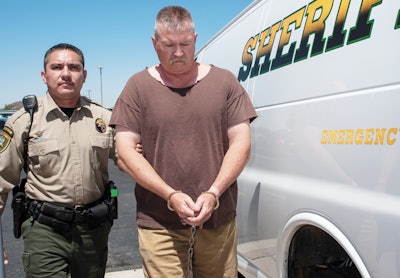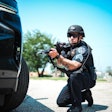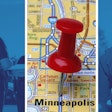 Photo: Mark W. Clark
Photo: Mark W. Clark
Every year, prisoners escape custody. Often this happens because someone missed a crucial safety step during transfer to another jail facility or to court. Sometimes a prisoner’s cuffs are too loose or the person gets access to a key or other cuff-defeating tool. Sometimes officers are injured or killed during the process. But using the proper restraints and techniques for each prisoner transfer situation will help ensure the safety of yourself and other law enforcement officers.
Restraints are probably the first things that come to mind regarding safe transport of any subject, and many options exist. For handcuffs alone the list includes disposable, hinged, chained, and rigid models—from various companies. When it comes to transporting prisoners between facilities, items such as belly chains and leg irons enter the mix as well. The key is knowing when and how to use each, alone and in different combinations.
Chain cuffs are the easiest to put on, but provide the wearer the most ability to move. Hinged cuffs only allow a prisoner to move his or her hands up and down: some linear movement, but no lateral or angular movement. This makes them better suited for transportation over long distances. Rigid cuffs severely restrict wrist movement: no angular, no lateral, no linear movement. They are the most difficult to put on, but also the most difficult for the prisoner to defeat.
“Our best security product for transporting between correctional-type facilities or from a county to a larger facility or from a city jail to a county jail is the rigid cuffs,” says ASP trainer and retired Dallas police sergeant Daryell Harmon. “If I have to transport them over water, the rigid cuff allows me to do a handcuffing procedure in front of their body and I could actually get a lifejacket over them, but at the same time it decreases their mobility and their ability to attack an officer.”
Harmon typically uses stacking, which he describes as the “I Dream of Jeannie pose,” when securing prisoners with rigid cuffs. The prisoner’s arms are parallel to each other, but the palms of the hands face away from each other, with the six- to eight-inches of the cuff between the two hands.
Belly chains and transport belts made in various styles of different materials allow you to further restrict movement by securing these or other handcuffs to the waist and even connecting leg irons along a longer chain. For example, Humane Restraint sells transport belts made of leather or nylon fitted with D-rings and handcuffs that can be secured with either Velcro or buckles, according to Stacy Schultz, general manager. These can also help maintain order and efficiency. “All of our nylon restraints are available in colors,” he says. “You can color code for departments or units within a facility, or maybe assign a risk level with a color.”
If you’re transporting multiple people to the same facility at once, you can use a long transport chain created for the purpose to connect five people, for example, with five sets of cuffs and or leg irons attached at intervals along the chain. Peerless makes these chains to meet individual agencies’ needs, as well as custom restraint systems for unusually large or small prisoners.
Conductive Cuffs
Another restraint option is the Stun-Cuff. It’s a pain compliance device that is placed around the wrist or ankle and uses electrical bursts dispensed via a wireless transmitter to keep prisoners in line. Deputies and others transporting prisoners demonstrate the Stun-Cuff before fitting it on a prisoner. This entails holding the cuff out and activating it with the transmitter so that the prisoner can see and hear the electrical arc created.
Brad Myers developed the Stun-Cuff and serves as president of manufacturer Myers Enterprises. He recommends a two- to three-second burst to gain compliance when needed. After pressing the “on” button, holding the “fire” button down for longer intensifies the pain, although the amount of electricity is not increased. But the demonstration is usually enough to convince a prisoner to comply while wearing the device.
“In each case that we have demonstrated the Stun-Cuff, we notice a better disposition by the prisoner,” says Sgt. Mike Middleton, who supervises the Warrants and Fugitives Division of the Caddo Parish (La.) Sheriff’s Office. “After three years, we have never actually had to stun anyone.”
One reason Middleton prefers the Stun-Cuff is that a prisoner he was transporting from a large Texas county jail tripped and fell over the chain of his leg restraints when it became trapped in the track of an elevator. The person wasn’t able to break his fall because he was wearing a belly chain, and Middleton couldn’t get to him quickly enough to catch him. “Fortunately, he was not seriously injured and we made the trip,” Middleton says.
Myers sees his invention as an equalizer that gives those in law enforcement the upper hand through the wonders of technology. No matter the size of the prisoner, wirelessly transmitted pain is easy to administer and prevent unruly behavior. With the multi-cuff transmitter, one deputy can control as many as nine prisoners, with the ability to activate individual prisoners’ devices, or all of them at the same time if necessary.
“Unfortunately, there are too many transports taking place with personnel getting older, like elderly bailiffs,” says Myers. “If one of them gets stuck in fisticuffs with a tough guy, he might get hurt. But you put the Stun-Cuff on and the deterrent’s there. Hopefully it prevents that.”
OK to Cuff in Front
Proper cuffing techniques for prisoner transport differ from those used after initial arrests on the street. And it’s not just because of security issues. The safety of the person being restrained also comes into play.
When you’re out in the field and you cuff someone, you put the subject’s hands behind his or her back to decrease the person’s mobility for safety reasons. This is especially important because you’re most likely using chain handcuffs that would otherwise provide the cuffed person with a great deal of mobility. However, transporting someone in the back of a squad car to the station doesn’t usually take more than a few minutes. Traveling with hands behind the back for extended periods of time can cause discomfort and even injury.
“Cuffing in front is easier on the shoulders and the back of the suspect,” explains ASP’s Harmon. “They’re not sitting with their hands behind their back, so they’re not leaning and applying pressure to the wrists. This matters because they’re usually going longer distances if going from facility to facility.”
As mentioned earlier, traveling over water brings about different concerns for the prisoner. He or she must be able to wear a lifejacket and be able to move in certain ways should an emergency occur.
“Many airlines won’t allow a person to be handcuffed behind the back because of Coast Guard rules and being able to get someone out [for emergency landing and rescue], so handcuffing in the front is the acceptable way to transport prisoners via airplane,” Harmon says.
High Security
Certain prisoners require higher security measures than others. For this reason, Peerless and ASP both manufacture a line of high-security products with special locks that will only open with specially coded keys to match. This prevents the use of universal handcuff keys, even if one has been successfully hidden in a prisoner’s clothes or body.
“This high-security product uses an Assa Desmo or Medeco key,” says Peter Gill, president of Peerless Handcuff Company. “You can order these keys so that individual sets are keyed differently or all alike.”
Unique key codes make sure no one else will have the same key, even other law enforcement agencies. “We keep tight control over what the key codes are and how they’re reproduced,” says Gill.
These high-security locksets can be used to severely reduce the chances of a highly dangerous prisoner or proven escape artist from defeating his or her restraints, says ASP’s Harmon. For such people, he recommends giving a coded key to one deputy at the point of origin, one key to a deputy or bailiff at the arrival point, and maybe one key to someone in a trailing car in case there is an emergency during transport that requires the prisoner to be released from his restraints. He would not allow any person immediately surrounding the prisoner during transport to have a coded key on his or her person. This way, even if the prisoner were able to overpower someone, he or she would not be able to access a key that could open the restraints.
Devices that cover already restrained hands are also available to more securely prevent a prisoner from using his or her hands. Examples include the Hand Restraint Mittens from Restraint System Technologies and Humane Restraint’s CuffMuzzle bag.
“It simply works by putting a handcuffed person’s hands into this bag,” says Humane Restraint’s Schultz. “It’s divided so the hands are kept separately. A reusable locking strap on it allows for secure control over the individual and keeps them from manipulating contraband.”
U.S. Marshals use what is called a black box or blue box, depending on the manufacturer, that fits over handcuffs and blocks the keyholes so it’s more difficult for someone to gain access to them and get out of the cuffs.
Many agencies also use different versions of the Stun-Cuff to keep high-security prisoners from attempting escape.
Courtroom Considerations
Getting prisoners to court carries its own set of challenges. Chief among them is the need to keep visible restraints from view as much as possible to keep from unduly causing a jury to see a defendant as a criminal before proven guilty.
For this reason, leg braces that can be worn under pants are a good solution. Humane Restraint sells a leg brace that fills this need. “There are three nylon straps and one locking leather strap that actually locks to the person’s leg,” explains Schultz. “The brace allows the person to sit, and then when they stand up, the leg brace snaps into an upright position. In order for them to bend their leg again, to sit again, they have to lift the lever up on this leg brace, and it allows them to bend their knee and sit down. The best thing about this is it prevents the person from running or kicking, but it can be worn under clothing so it cannot be seen by the jury.”
Peerless Handcuff Company sells a waist chain system that keeps a prisoner’s hands secure but allows him or her to manipulate items, which can be necessary during a trial. “The cuffs on the 7003b are positioned on the waist chain so that they are right in front of the navel and the wrists are together,” explains Gill. “So someone handcuffed in the front can manipulate things in their hands, whether they need to flip through documents or sign something.”
“As most in our business know, every effort is made to not have a noticeably restrained defendant in court. Of course, this is to not prejudice jurors,” says Middleton. His restraint of choice for such situations is the Stun-Cuff. It can be worn on the ankle under pants so it’s not visible. Deputies and bailiffs can hold onto the transmitter to “fire” the Stun-Cuff and control the person without anyone on the jury needing to be aware of the device.
Complacency Kills
Everyone knows this, but it’s easy to forget: No matter how well you’ve secured any prisoners, it’s important to thoroughly search and constantly supervise them.
“In Georgia, a prisoner had a hidden handcuff key, and he slashed an officer in the throat in front. It came from not ensuring that all of the steps were followed,” says ASP trainer Harmon. “We can learn from that officer’s sacrifice.”
It doesn’t matter how many times a prisoner has been searched by other people. You need to search that person yourself. Taking it a step further, Harmon says he has always insisted that officers taking over custody of a prisoner from him conduct a search as he’s watching or he won’t leave.
Someone else might have missed a small handcuff key or sharp weapon hidden in the prisoner’s clothes or even in his or her body. This is one reason why the B.O.S.S. (Body Orifice Security Scanner) from Ranger Security Detectors is a great safety device. But that is not a replacement for effective searches. If you look for the small things like hidden keys and lock picks, you’ll definitely find the big things like knives and guns, Harmon says.
“A common misconception is, ‘They’re handcuffed so they’re safe,” says Harmon. “If I have my hands cuffed behind me, I can still kick you, knee you, head-butt you, bite you, wrestle you to the ground, shoulder-butt you. I can do a lot of things with my body as an attack to create a lot of harm on the officer.”
While monitoring prisoners and checking restraints for correct tightness (whether they’re too big or too small), also remember to keep watch for people on the road who might be attempting to help a prisoner escape. Situational awareness always applies.
And it’s not enough to learn how to handcuff. Training should be ongoing, both to enhance muscle memory and to introduce any new useful techniques.
“Guys use handcuffs way more than they ever use their firearm. And yet we put a ton of emphasis on firearms, and very little emphasis other than your basic training academy on handcuffs,” laments Harmon.
Peerless’ Gill agrees that training is paramount. “Get proper training and get refresher courses if need be to stay up to speed on it,” he says.
Yet no matter how much training you’ve received or how often, complacency can always creep in if you’re not vigilant.
“The training that we give officers on what we call our procedure of stacking includes constant monitoring of the subject, not being complacent in your duties,” adds ASP trainer Harmon. “Many times you’ve done it 100 times so it’s like, ‘OK, this is nothing.’ It’s that 101st time that it becomes a problem because you become complacent.”
Prisoner Transport Restraints
Prisoner Transport Car Seating Solutions
















